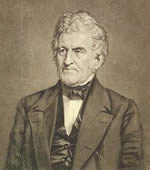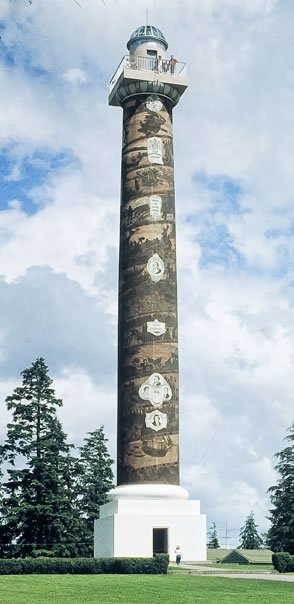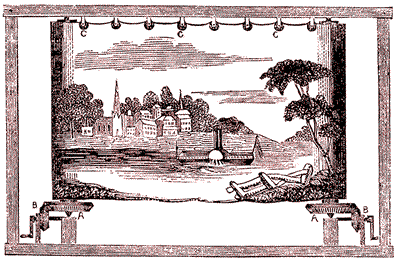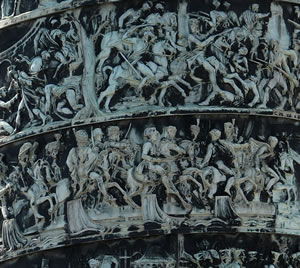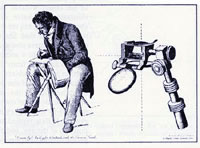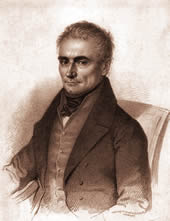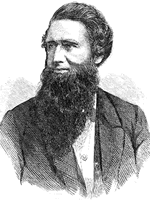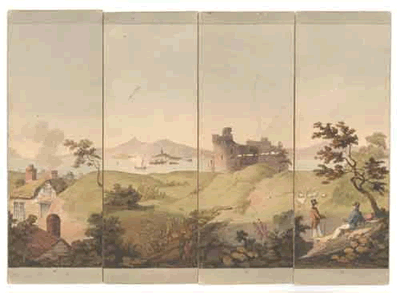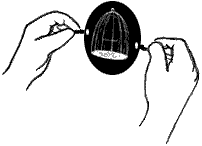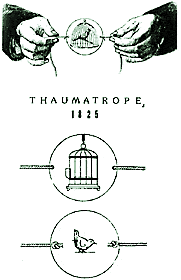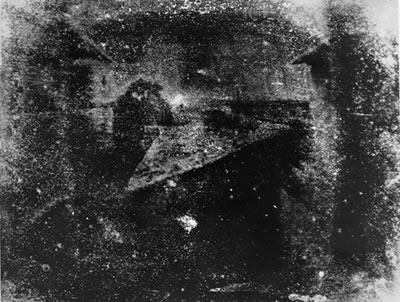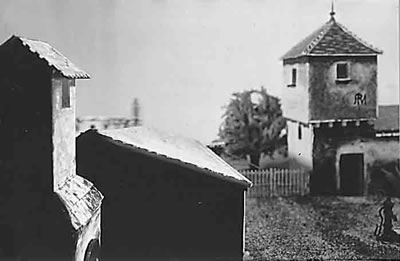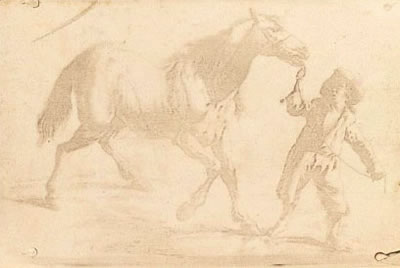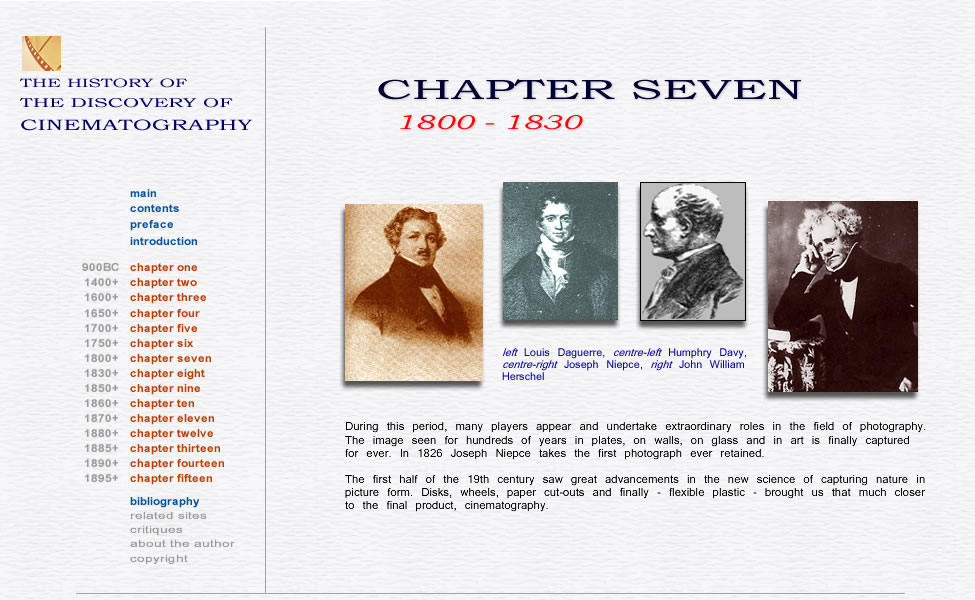 |
| |
|
|
|
| |
|
|
|
| |
1800
(Sir) HUMPHRY DAVY (1778 - 1829) |
|
|
| |
Davy provides us with
the most brilliant light yet used in projection, the electric (carbon)
arc lamp. The work is recorded in Nicholson's Journal
of 1800 as well as the lectures of Silvanus Thompson (Journal of the
Royal Society of Arts, October 1895, On the Arc Light). |
|
| |
|
|
|
| |
|
|
|
| |
|
|
| |
|
|
| |
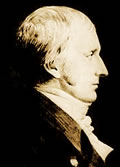 |
1800
THOMAS WEDGEWOOD (WEDGWOOD) (1771 - 1805)
The son of the famous
potter Josiah, Wedgewood‚€™s previous work in experimenting with
silver salts almost comes to fruition when he is able this year
to make an image. Wedgewood was unable however to keep it from
darkening.
Thomas Wedgewood |
|
|
| |
|
|
|
| |
|
|
|
| |
|
|
| |
|
|
|
| |
1801-1802
PAUL M. PHILIPSTHAL ( - ) |
|
|
| |
Either in 1801 0r 1802,
Philipsthal gave Robertson‚€™s Fantasmagorie the English
spelling Phantasmagoria and began presenting shows in
London at the Lyceum Theatre. Philipsthal was a German showman and was
primarily responsible for the invention of ‚€˜dissolving views‚€™,
however Childe advanced it greatly. On seeing one of Philipsthal's performances
at the Lyceum, Sir Humphry Davy wrote; |
|
| |
|
|
|
| |
“The
small theatre of exhibition was lighted only by one hanging lamp, the
flame of which was drawn up into an opaque chimney or shade when the
performance began. In this 'darkness visible' the curtain rose and displayed
a cave with skeletons and other terrific figures in relief upon its
walls. The flickering light was then drawn up beneath its shroud, and
the spectators in total darkness found themselves in the middle of thunder
and lightning.
A
thin transparent screen had, unknown to the spectators, been let down
after the disappearance of the light, and upon it the flashes of lightning
and all the subsequent appearances were represented. This screen being
half-way between the spectators and the cave which was first shown,
and being itself invisible, prevented the observers from having any
idea of the real distance of the figures, and gave them the entire character
of aerial pictures. The thunder and lightning were followed by the figures
of ghosts, skeletons, and known individuals, whose eyes and mouth were
made to move by the shifting of combined sliders. After the first figure
had been exhibited for a short time, it began to grow less and less,
as if removed to a great distance, and at last vanished in a small cloud
of light.
Out
of this same cloud the germ of another figure began to appear, and gradually
larger and larger, and approached the spectators till it attained its
perfect development. In this manner, the head of Dr. Franklin was transformed
into a skull; figures which retired with the freshness of life came
back in the form of skeletons, and the retiring skeletons returned in
the drapery of flesh and blood. The exhibition of these transmutations
was followed by spectres, skeletons, and terrific figures, which, instead
of vanishing as before, suddenly advanced upon the spectators, becoming
larger as they approached them, and finally vanished by appearing to
sink into the ground. The effect of this part of the exhibition was
naturally the most impressive.
The
spectators were not only surprised but agitated, and many of them were
of the opinion that they could have touched the figures.”
|
|
| |
|
-
Davy |
|
| |
|
|
| |
|
|
|
| |
1802
ROBERT HARRUP ( - ) |
|
|
| |
Harrup substantiated the
previous experiments of C. W. Scheele in discovering that heat had no
effect on silver compounds with respect to darkening. Harrup‚€™s own experiments
on mercury salts under several environments proved again that light was
the cause. |
|
| |
|
|
|
| |
|
|
|
| |
1802
THOMAS WEDGEWOOD (WEDGWOOD) (1771 - 1805) |
|
|
| |
Wedgewood published a
process he calls ‚€˜sun-printing‚€™. He had duplicated previous work by Scheele
and Schulze. Wedgewood placed sensitized papers out under the sun but
could not keep the sheet from going completely black. |
|
| |
|
|
|
| |
|
|
|
| |
19TH CENTURY |
|
|
| |
Throughout the whole of
the 19th century, room camera obscuras became more popular and were being
built across Europe and Britain. Many observatories were reconstructed
which included telescopes as well. Although not as frequent across the
landscape as our movie theatres of today are, they flourished as a form
of entertainment to the traveler as well as the locals. Seaside resorts
and hilltop locales were popular venues. For a detailed study of today's
existing room camera obscuras, see John Hammond‚€™s The Camera Obscura,
A Chronicle, 19th Century section, (Adam Hilger Ltd., Bristol,
1981). A fine online collection of camera obscura rooms may be seen
at the Magic
Mirror of Life. |
|
| |
|
|
|
| |
In the early 1800‚€™s, the
portable camera obscura began to look more and more as the camera of today.
By the 1830‚€™s, the camera obscura was ready and waiting for a medium to
capture its images and keep them. It had provided all it could in the
form of a curiosity, and after the discovery of fixed-image processes,
the camera obscura went on to provide a more serious, yet breathtaking
form of entertainment never previously imagined. As well, the camera obscura‚€™s
cousin, the magic lantern had a illustrious career of it‚€™s own. Read on
and learn of the diorama, panorama, dissolving views and the infamous
Phantasmagoria. |
|
| |
|
|
|
| |
|
|
|
| |
|
|
| |
|
|
| |
| 1802
ROBERT HARE (1781 – 1858)
Invented the oxygen-hydrogen
blowlamp, paving the way for the magic lantern to become more
and more used by professional showmen and the like on much larger
scales.
The process consisted
of the oxy-hydrogen flame being blown against the lime, thereby
producing a most brilliant light, second only to the arc lamp
and the sun itself. |
|
Robert
Hare |
|
|
| |
|
|
|
| |
|
|
| |
|
|
| |
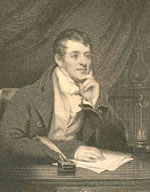 |
1802
(Sir) HUMPHRY DAVY (1778 - 1829)
Davy reported on Wedgewoods‚€™
works to date in his paper to the Royal Society in London, ‚€˜On
An Account of a Method of Copying Paintings on Glass And of Making
Profiles by The Agency of Light Upon Nitrate of Silver, Invented
By Thomas Wedgewood, Esquire‚€™.
We find in the report,
‚€œthe images formed by means of a camera
obscura have been found too faint to produce, in any moderate
time, an effect upon the nitrate of silver.‚€Ě
Sir Humphry Davy |
|
|
| |
|
|
| |
|
|
| |
|
|
|
| |
|
|
|
| |
1803
PAUL M. PHILIPSTHAL ( - ) |
|
|
| |
Philipstal provided an
evening or two of enjoyment with his version of the Phantasmagoria
as reported by Brewster. The apparitions were apparently produced within
a small room such as an apartment and included music! At least a century
before Kircher‚€™s show (which would place it at approximately 1540), the
history of CELLINI provides us with a report on a Phantasmagoric-type
show presented at the Coliseum, documented by Roscoe in his ‚€˜Life
Of Benvenuto Cellini‚€™. Brewster also, has quoted this event.
Philipstal‚€™s lantern shows were known to have resided upon tracks or rails.
Phantasmagoric visions were seen upon a translucent sheet
or similar material as opposed to the dissolving view were an opaque background
was required. Philipsthal not only introduced the Phantasmagoria
into England, he also invented the idea of the Dissolving View. |
|
| |
Dissolving Views were also known as Melting Sights,
or Mist Pictures. |
|
| |
|
|
|
| |
|
|
| |
|
|
|
| |
| 1805
ASTOR COLUMN (also known
as the ASTORIA COLUMN)
The beginning of cinematic
story-telling of the history of Astoria, Oregon starts in 1805.
The Lewis & Clark Expedition
arrived in Astoria this year following the discovery of the Columbia
river by Robert Gray in 1792. Thus begins the journey of the spiral
frieze-mural on the Astor Column. It tells the story of early
Oregon history from its discovery right through to the time of
the early white settlers beyond 1811.
The mural spirals upwards as
do all true columns with depictions. It was modeled after Trajan's
Column [SEE TRAJANS COLUMN] and is
125 feet in height. The column boasts being the world’s
largest memorial column made of reinforced concrete. The mural
was completed in the sgraffito style. The original was painted
by Atillio Pusterla. It was refurbished in 1995.
The column stands on the 600
foot high Coxcomb Hill, Oregon's highest point. The Astor Column
contains over 200 figues in its cinematic story-telling and if
unraveled would span more than 500 feet in length. A one-reeler
of the silent era in contrast, would hold approximately 1,000
feet of film and run 10 minutes. It depicts 14 separate 'scenes'
as a movie would, and commemorates Oregon history as it ascends
from base to top in chronological order.
On the interior, visitors may
ascend a 164-step staircase to the top. The view offers the Pacific
Ocean as well as the Columbia River.
The 14 scenes of the Astor
Column from base to top reads as a treatment;
14 - White
settlers begin arriving and the building of the railroad
13 - Fort Astoria returned to the United States 1818
12 - Fort Astoria sold to the British and named Fort George 1815
11 - Pacific Fur Company group arrives 1812
10 - Pacific Fur Company ship the Tonquin destroyed at Vancouver
Island 1811
9 - Astor arrives at Astoria in 1811 and begins building Fort
Astoria
8 - John Jacob Astor of the Pacific Fur Company sails to Astoria
1810
7 - Lewis & Clark Expedition builds Fort Clatsop
6 - Lewis & Clark Expedition spends the winter of 1805-1806
near Astoria
5 - Lewis & Clark Expedition boil sea water in order to produce
salt
4 - Lewis & Clark Expedition at Astoria 1805
3 - Earl village of Astoria
2 - Columbia River discovery by Robert Gray 1792
1 - Early Wilderness and Native Americans
The Astor Column was erected
in 1926. |
|
The
Astor Column (above) is a spiral mural standing 125 feet
tall |
Photo
Source/Credit: Jerry Matchett |
|
|
|
| |
|
|
|
| |
|
|
| |
|
|
| |
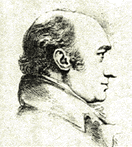 |
1806
WILLIAM HYDE WOLLASTON (1766 - 1828)
The unskilled artist was assisted greatly with the coming of Wollaston‚€™s
Camera Lucida. Lucida being the Latin for ‚€˜light‚€™,
the lucida was strictly an artist's tool for use in the day for
etchings, drawings and artwork in general. Perspective was ensured
by this lightweight and easy to use instrument containing a prism
which the user looked through to see his subject below on his paper.
Nicholson‚€™s Journal wrote in 1807 on the lucida
(‚€˜Description of the Camera Lucida, vol. 17, June 1807).
This instrument should not be confused with nor compared to Hooke‚€™s
camera obscura (SEE 1680 HOOKE) which
he had called a lucida. Durer (sighting tubes, grids) and
Alberti (intersector) both used devices, which allowed
the ease of artistry. |
| W.
H. Wollaston depicted in a drawing (above) made by his own
invention, the camera lucida. |
|
|
| |
|
|
|
| |
|
|
|
| |
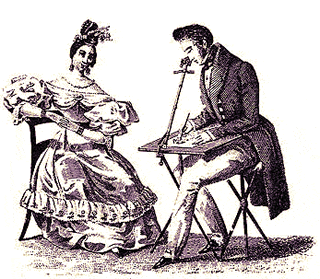 |
Wollaston's camera
lucida (left) was an eventful invention indeed. Novice artists
as well as the unskilled could produce a rendering with relative
ease with its use. Consisting of an extendible telescopic tube in
three pieces, with 45-degree prism and sighting lens, the Lucida
caught on in popularity quickly. The user looked downward through
the eyepiece at the subject, which was seen on the flat surface.
The device was secured to the drawing table for stability.
The reader will recall Alberti's Intersector and
the Sighting Tubes of Durer (SEE
ALBERTI 1457 and DURER 1525). These
instruments as well, were similar and produced desired effects in
simple drawings and etchings. Nicholson's Journal
in 1807 wrote an article on the camera lucida entitled ‚€˜Description
of the Camera Lucida'. It was published in volume 17. |
|
|
| |
|
|
| |
|
|
| |
|
|
|
| |
|
|
|
| |
1807
JAMES THAYER ( - ) |
|
|
| |
Thayer was an American
who purchased a Panorama in Paris and proceeded to build
two enormous rotundas (of 17 m/56 ft diameter) on the boulevard Montmartre.
Their location is remembered by the naming of a lane way as Passage des
Panoramas. Two of his Panoramas were called 'A
View of Paris' and 'The Evacuation of Toulon by the British
in 1793'. Thayer commissioned the French artist Pierre Prevost
to paint for a new location, with enormous proportions. It was located
between the rue Neuve-Saint-Augustin and the boulevard des Capucines with
measurements in excess of 93 feet (radius) and exhibits of 330 feet (diameter)
by 48 feet (high). The structure could seat 150 per show and patrons sat
no closer than 36 feet from the screen. Thayer's paintings were done by
Pierre Prévost and Charles Bouton to name two. |
|
| |
|
|
|
| |
|
|
| |
|
|
|
| |
| 1810
- 1880's THE MOVING PANORAMA
The Moving Panorama
was extremely popular from the early 19th century to the later
part of the century. Unlike the fixed Panorama,
this one 'moved' before the audiece.
The Moving Panorama
was as short as 100 feet and sometimes as long as 1,000 or longer.
The Federal Procession of 1788 in
Philadelphia was depicted at 1,300 feet in 1811.
Wound on a giant supply spool
just like in a film projector, the Moving Panorama
was cranked over onto the take-up spool, but not before passing
behind a facade or proscenium to give the impression of being
in a theatre.
The facade also hid the spools
and cranking mechanism from the audience. A speaker would always
provide a narration as the painted mural passed before an enthralled
audience. |
|
| |
The
Moving Panorama (right): How Much Closer Can We Get
To Cinematography in 1810? These painted giants were produced
by men like John Banvard and Moses Gompertz. Moving
Panoramas were popular throughout the US, Canada, Europe and
the UK right up until the 1880's. |
|
|
| |
|
|
|
| |
| 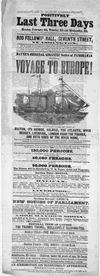
|
Early Moving Panoramas
were popular for their variety of scenery; parades and other
celebratory public events, common street scenes, battles both
on ground and the sea, harbours from around the world, arctic
voyages, the Great Lakes, local country life as well as cultural
views of foreign countries, city view-scapes and many more
depictions too numerous to mention. The Marshall Brothers
of Edinburgh may have been the first to show their Moving
Panoramas throughout the UK.
Some of the great Moving
Panoramas were entitled; John Vanderlyn's Panoramic
View of the Palace and Gardens of Versailles (1819);
The Marshall Bros.'s The Coronation of George IV
(1823) and their The Battle of Bannockburn (c.1824);
John Martin's The Departure of the Israelites from Egypt
(c.1835); John Skirving and Joseph Kyle's John Bunyan's
Pilgrim's Progress (1850-1851); Godfrey N. Frankenstein's
Moving Panorama of Niagara Falls (c.1850); Arctic
Explorations (1855); Thomas F. Davidson's A Whaling
Voyage (1860); Benjamin Russell and Caleb Purrington's
Whaling Voyage Round the World (1848) [Melville
based parts of Moby Dick on accounts shown in this same Panorama].
Moving Panoramas
were 'peristrephic'. The scrolling painting was pulled across
a very slight convex (curves outward) surface or
wall as opposed to a flatter surface. This added an extra
sense of movement and depth to the viewer.
Rotundas were specifically
built for both the stationary and Moving Panoramas.
This handbill (left) from 1880 is from an exhibition
by Walter Bayne for his Bayne's Original Gigantic
Series of Panoramas Entitled A Voyage To Europe!
|
| This
original painting by Bayne, was based on his own sketches and
although the size is not known, Bayne boasted that it "constituted
by far the largest Panorama ever presented to the public".
According to Bayne it took three years to construct. |
|
|
| |
|
|
|
| |
View A Large Format Image
Of This 1880 Handbill Here |
Panorama comes from the Greek "all-embracing
view" and "all sight". |
|
| |
|
|
|
| |
|
|
|
| |
|
|
| |
|
|
| |
| 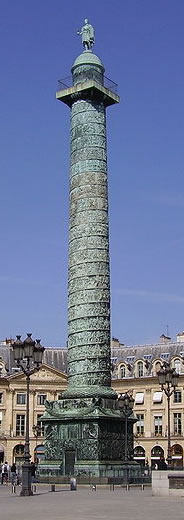
|
1810
THE PLACE VENDÔME COLUMN
Another column patterned after Trajan's Column is The
Place Vendôme Column built between 1806 and
1810 by Napoleon following his victory in the battle of Austerlitz.
Meant to tell the story
of this Napoleanic victory, the spiral bronze bas-relief works
it's way up the column with 425 spiralling veneer plates.
The Battle of Austerliz
(1805) is told in cinematic fashion from bottom to top by
the sculptors Pierre-Nolasque Bergeret, Louis-Simon Boizot,
Claude Ramey, Corbet, Henri-Joseph Ruxthiel, François
Bosio, Lorenzo Bartolini, Jean-Joseph Foucou, Clodion and
Francois Rude.
The 425 spiraling bas-relief
bronze plates were made out of cannon taken from the combined
armies of Europe, (hugely exaggerated) at 1250: 120-133 cannon
were actually captured at Austerlitz.
The square where The Place
Vendôme Column stands is surrounded by shops of some
of the most famous names in fashion, as well as the Hotel
Ritz.
The 144 feet column has
had other names; first known as des Conquêtes
(interpreted as Conquests Square), then The Colonne d'Austerlitz,
then The Colonne de la Victoire (interpreted as The
Victory Column) and also The Colonne de la Grande Armée
(interpreted as The Column of the Great Army).
The original statue of
Napoleon created in 1810 was later removed and replaced with
a new statue in 1833. This in turn was replaced with another
statue - the present statue.
The spiral bronze bas-relief
was created by Bergeret and the column, being a stone core,
is surrounded by the bronze.
The Place
Vendôme Column (left) as it looks today.
|
|
The Napoleanic Wars
are depicted in The Place Vendôme Column's spiralling
bas-relief (right).
The obelisk-monument
erected to the glory of Napoleon the Great's Grande
Armée, begun on 25 August 1806 and finished 15
August 1810.
The column was to
be decorated with 108 friezes climbing in a spiralling
fashion, upwards and topped with a statue of Charlemagne
but this was later abandoned.
Like other columns
found around the world depicting events of history through
story-telling, The Place Vendôme Column's friezes
wind their way 'round the column depicting the major
events of this Napoleanic campaign.
|
|
Close-up
of the bas-relief of the The Place Vendôme Column
(above). |
|
|
|
| |
|
|
| |
|
|
| |
|
|
| |
|
|
| |
1811
CORNELIUS VARLEY (1781 - 1873)
This artist and scientist
developed a version of a camera lucida which he called a Graphic
Telescope. This device was actually a combination of
telescope, and lucida. He patented it in 1811.
The Graphic Telescope
had of course, a telescopic lens, which allowed the easier drawing
of objects or subjects at greater distances. |
|
| This
illustration (right) of the camera lucida in use, is
from an orignal drawing made by Cornelius Varley. |
|
|
| |
|
|
|
| |
|
|
| |
|
|
|
| |
|
|
| |
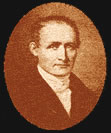 |
1814
JOSEPH NICEPHORE NIEPCE (1765 - 1833)
This
year, Niépce begins his work in earnest, on the art form
that would be known initially as Heliography. Just
twelve years later he would go down into history as the one who
captured the first image.
J.
N. Niépce 1765-1833 |
|
|
| |
|
|
| |
|
|
| |
|
|
|
| |
|
|
|
| |
1815
DAVID BREWSTER (1781 - 1868) |
|
|
| |
Brewster was a Scottish
inventor and scientist who gave the world the Kaleidoscope,
a toy that would bring millions around the world a visually pleasing spectacle
of twisting and turning colours and shapes. In 1819 he wrote and published
a Treatise on the Kaleidoscope. |
|
| |
|
|
|
| |
|
|
|
| |
1816
JOSEPH NICEPHORE NIEPCE (1765 - 1833) |
|
|
| |
Niépce documents
his belief that ‚€œmaking drawings by means of
light‚€Ě is a real possibility. He builds a camera obscura with
a microscope lens and produced a picture that he took using muriate of
silver, creating a negative image on semi-transparent paper (described
and included in a letter written to his brother Claude
dated 28 May 1816). |
|
| |
|
|
|
| |
In the letter, Niépce
writes . . .
"As there is less light inside the
box the image becomes clearer and its outlines as well as the dark and
light patches are more sharply defined. You can see this if you look
at the roof of the pigeon house, the angles of its walls, the casement
window of which the lattices are visible, the glass even seeming transparent
in some places. In short, the paper retains an exact imprint of the
coloured image, and if everything cannot be seen distinctly is because
the image represented here being very small, this object appears as
it would if seen from very far away. The pigeon house being depicted
in reverse, the barn, or rather its roof, is on the left instead of
on the right. That white mass to the right of the pigeon house above
the fence, which is not very clear but just as it appears on the reflected
image, is the de Beurré-blanc pear tree, which is much further
away and that spot on the upper part of the tree is a patch of light
visible between the branches. The shadow on the right side indicates
the roof of the bake house which appears lower than it should, because
the boxes (camera obscura) are placed about 5 feet from the ground of
the room. Finally, my dear friend, those little white streaks over the
barn are branches of the trees in the orchard of which one catches a
glimpse and which are reflected on the "retina". The effect
would be more striking if, as I have told you, or as I don't need to
tell you, the order of the dark and light parts could be reversed."
|
|
| |
|
|
| |
|
|
| |
|
|
| |
|
|
| |
1818
JAN (JOHANNES) EVANGELISTA PURKYNE (1787 - 1869)
A Czechoslovakian physician
who talked about persistence of vision and the ability of the
retina to retain images after the eyes no long see the subject.
He wrote on light intensity and how when light decreases, red
objects fade quicker than objects that are blue when they are
of the same brightness.
One of his works was
'Observations and Experiments Investigating the Physiology of
Senses and New Subjective Reports about Vision'.
Purkyne is also known for
coining the terms 'plasma', 'protoplasm' and recognized fingerprints
as important to criminal investigations. |
|
|
|
| |
|
J.
E. Purkyne |
|
| |
|
|
|
| |
|
|
| |
|
|
|
| |
|
|
|
| |
1819
CHARLES CHEVALIER (1804 - 1859) |
|
|
| |
In order to alleviate
achromatism, Chevalier began work on replacing the lens and mirror of
the camera with a prism containing lens surfaces. His work will be finished
in 1823 with his ‚€˜meniscus prism‚€™. Just seven years before
the first permanent photograph was taken, Niépce ordered a meniscus
prism from Chevalier. Niépce was not pleased in his experiments
with it and sent it back to Chevalier. Chevalier's prism was constructed
for use in the camera obscura, to be used in drawings and engravings.
Gernsheim has suggested that Niépce used the prism in the taking
of the photograph at Le Gras. This is unlikely. |
|
| |
|
|
|
| |
|
|
|
| |
|
|
| |
|
|
| |
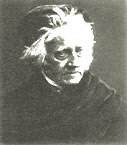 |
1819
JOHN FREDERICK WILLIAM HERSCHEL (1792 - 1871)
Herschel
now discovers that hyposulphite soda would dissolve silver halides
and begins working further to introduce a ‚€˜hypo‚€™
which eventually will stop the action of light on light-sensitive
salts. This ‚€˜hypo‚€™ becomes the mixture photographers
will need to 'keep' their photographs thus taking us closer to the
permanent Photograph, and Cinematography.
John
Herschel 1792-1871 |
|
|
| |
|
|
| |
|
|
| |
|
|
|
| |
|
|
|
| |
1820
- THE PROTEAN VIEW
A
smaller version of the Diorama begins to be seen, manufactured
for personal use, in the home. This miniature seems to have eluded many
because little is known about it. |
|
| |
|
|
|
| |
|
|
|
| |
|
|
|
| |
1821
JEAN-BAPTISTE BIOT (1774 - 1862) |
|
|
| |
Pictures up to twenty
times life size were possible with a camera obscura Megascope
according to Biot. He illustrated such with description suggesting that
a meniscus lens could further advance the image. |
|
| |
|
|
|
| |
|
|
|
| |
|
|
| |
|
|
|
| |
1822
LOUIS JACQUES MANDE DAGUERRE (1787 - 1851) |
|
|
| |
Daguerre opens the first
Diorama in rue Sanson, Paris. Daguerre provided scenes
of The Interior of Trinity Chapel (painted by Charles
Bouton), along with the Valley of Unterwalden and
Canterbury Cathedral (Daguerre). The scenes
consisted of elaborate landscapes and places well known to the public.
The large scale paintings on canvas were huge, measuring 14 metres by
22 metres. These translucent paintings were lit from behind and could
be made brighter or less, according to the mood or atmosphere the operator
wanted. |
|
| |
|
|
|
| |
A review of the
event is as follows;
"The
visitors, after passing through a gloomy anteroom, were ushered into a
circular chamber, apparently quite dark. One or two small shrouded lamps
placed on the floor served dimly to light the way to a few descending
steps and the voice of an invisible guide gave directions to walk forward.
The eye soon became sufficiently accustomed to the darkness to distinguish
the objects around and to perceive that there were several persons seated
on benches opposite an open space resembling a large window. Through the
window was seen the interior of Canterbury Cathedral undergoing partial
repair with the figures of two or three workmen resting from their labours.
The pillars, the arches, the stone floor and steps, stained with damp,
and the planks of wood strewn on the ground, all seemed to stand out in
bold relief, so solidly as not to admit a doubt of their substantiality,
whilst the floor extended to the distant pillars, temptingly inviting
the tread of exploring footsteps. Few could be persuaded that what they
saw was a mere painting on a flat surface. The impression was strengthened
by perceiving the light and shadows change, as if clouds were passing
over the sun, the rays of which occasionally shone through the painted
windows, casting coloured shadows on the floor. Then shortly the lightness
would disappear and the former gloom again obscure the objects that had
been momentarily illumined. The illusion was rendered more perfect by
the sensitive condition of the eye in the darkness of the surrounding
chamber." |
|
| |
|
|
|
| |
Daguerre was a larger-than-life
painter who seriously desired the real thing in his art and through the
Diorama he could achieve this effect by actually bringing
the scene to the theatre (almost). Daguerre began his early working years
as an architect, and soon after became an assistant stage designer for
a theatre. Daguerre was a gifted illusionist in terms of his ability to
design sets, which dazzled audiences. These designs he would later coin
as a ‚€˜Diorama‚€™. |
|
| |
|
|
| |
|
|
| |
|
|
|
| |
|
|
| |
1822
JEREMIAH GURNEY (1812 - 1886)
Gurney was an Englishman,
a doctor who developed the use of the calcium light system which
greatly enhanced the Dissolving Views by allowing
for enormous light for projection.
Gurney is also remembered
as the winner of a contest put forth by popular photographic-supplies
businessman E. Anthony.
The test was who could
produce the best whole-plate Daguerreotype.
Dissolving Views were also known as Melting
Sights, and Mist Pictures. |
|
|
|
| |
|
Jeremiah
Gurney |
|
| |
|
|
|
| |
|
|
|
| |
|
|
| |
|
|
| |
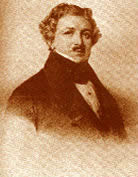 |
1823
LOUIS JACQUES MANDE DAGUERRE (1787 - 1851)
Daguerre
opens a second Diorama in Regent‚€™s Park, London.
It was Daguerre‚€™s work with the camera obscura (ensuring perspective
in his paintings for the Diorama), ), which leads him to desire
the ability to 'fix' the images. His painting ‚€˜The Ruins
of Holyrood Chapel‚€™, which now hangs in the Walker Art
Gallery in Liverpool, was completed with the use of the camera.
L.J.M.
Daguerre 1787-1851 |
|
|
| |
|
|
|
| |
|
|
| |
|
|
|
| |
|
|
|
| |
1823
CHARLES CHEVALIER (1804 - 1859) |
|
|
| |
Chevalier presents his
‚€˜meniscus prism‚€™ in the camera obscura instead of lenses
and mirrors. In doing this, he avoided the aberration created through
curved lenses (lost focus in the centre or fringe of the screen on
a plane screen) known as achromatism. |
|
| |
|
|
|
| |
|
|
|
| |
|
|
| |
|
|
|
| |
1824
JOHN CLARK ( - ) |
|
|
| |
In
1824 John Clark of London, designed and illustrated a child's
table game consisting of sixteen landscape cards with interchangeable
views. The game was was known as the Myriorama,
and was manufactured by Samuel Leigh.
Nineteenth century printing technology enabled the Myriorama
to become a very popular form of picture entertainment because,
as the first series of the Myriorama stated; "The
Myriorama is a moveable Picture, capable of forming an almost
endless variety of Picturesque Scenery".
The cards were first illustrated, then engraved and finally
coloured by hand. Varying scenes of the sea, rural cottages,
dales, castles, as well as rustic scenes, were fully interchangeable
and allowed the user to arrange them in any order thereby creating
a near-endless assortment of panoramic landscapes, "quite
picturesque".
Originally priced at 15 shillings when first published, and
lacking any true fluidity, this simple picture toy reminds one
of the smooth movements of the fading in and out from scene
to scene in a film.
|
|
| These
individual aquatint cards were 20 x 7cm in size, expanding to
20 x 112cm once assembled. |
Four
cards from a 16-piece set of a Myriorama © Leicestershire
County Council |
| |
|
|
|
| |
| |
|
|
| |
|
|
| |
|
|
|
| |
|
|
|
| |
1824
GEORGE BIRCKBECK (1776 - 1841) |
|
|
| |
This Englishman used the
calcium lights of Gurney in his magic lantern presentations. |
|
| |
|
|
|
| |
|
|
|
| |
1824
PETER MARK ROGET (1779 - 1869) |
|
|
| |
A london physician, Roget
had dabbled in the sciences, designing a logarithmic slide scale and becoming
well learned in the study of mass water systems. Roget was secretary of
the Royal Society and later lectured on perception, prior to his presentation
to the society of his ‚€˜Persistence of Vision With Regard To Moving
Objects‚€™. He provided an early definition of the phenomenon of
the backwards wheel in forward motion, touching upon persistence of vision.
Roget is better known of course for his thesaurus. |
|
| |
|
|
|
| |
|
|
|
| |
1824
T. T. DALES ( - ) |
|
|
| |
Dales creates a similar
picture toy to that of Clark's Myriorama. He calls his the Panoramacopia.
|
|
| |
|
|
|
| |
|
|
|
| |
|
|
| |
|
|
|
| |
1825
JOHN AYRTON PARIS (1785 - 1856) |
|
|
| |
A year before Fitton's
paper toy, Paris began manufacturing what he called a Thaumatrope.
It is a simple illusionary toy meant to imitate motion. It consists of
a circular disk made of paper, which has an image on each side. When twirled
by connected string, the images combine to give an animated effect. The
bird-in-a-cage was a popular theme. |
|
| |
Thaumatrope
is Greek and means 'Magic Motion'. The Thaumatrope
of Paris is a simplistic toy of motion, and supremely illustrates
the concept of persistence of vision. This circular Thaumatrope
(right) is a round piece of firm paper with a birdcage
on one side and the bird on the other. Holes at each end allow string
to be tied, and when the string is held taught in the fingers, can
be rolled between the finger and thumb. When this happens the two
images combine to create the Bird Cage effect. (Animation
courtesy Ruth
Hayes, Randon Motion).
|
|
|
|
| |
|
|
| |
|
|
| |
|
|
|
| |
|
|
|
| |
1825
WILLIAM RITCHIE ( - ) |
|
|
| |
Ritchie used a gas powered
lamp for projection of pre-Phantasmagoria in the magic
lantern. |
|
| |
|
|
|
| |
|
|
|
| |
|
|
| |
|
|
| |
1826
WILLIAM HENRY FITTON (1780 - 1861)
Fitton
devised a small circular disk made of paper, which twirled while
hanging on a string. On one side was a picture of a bird and on
the other, a picture of a cage. The bird appeared to be in the cage
once a certain speed was achieved. One JOHN AYRTON PARIS, a physician
from Edinburgh, began to commercially manufacture a toy, which was
strikingly similar. He called it a ‚€˜Thaumatrope‚€™
and described it in his ‚€˜Philosophy in Sport Made Science
in Earnest‚€™, 1826. W.H.Wollaston, Charles Babbage and Herschel
all have a hand in a similar invention.
Another paper
toy of Paris (right) from 1825 caught the imagination of
many, as the "Bird in the Cage". Whilst providing a glimpse into
the possibility of real movement, the Thaumatrope
is the simplest way of showing what Persistence of Vision
actually is. How else would we see the bird in the cage, except
by the latent action of the retina? The bird was drawn on one side,
and the cage on the other. (SEE ABOVE) |
|
|
|
| |
|
|
| |
|
|
| |
|
|
|
| |
|
|
|
| |
1826
PHILIP CARPENTER ( - d. 1833) & WILLIAM WESTLEY ( - )
|
|
| |
Philip Carpenter manufactured
top-quality magic lanterns and slides. Operating in London England, he
designed a mass-production process of creating copper-plated lanternslides.
His sister Mary Carpenter continued the business upon his death along
with William Westley. From 1835 the company was known as Carpenter &
Westley. |
|
| |
|
|
|
| |
|
|
|
| |
1826
THOMAS DRUMMOND (1797 - 1840) |
|
|
| |
Drummond was born in Edinburgh
Scotland and invented the signal light which produced lime light through
the use of calcium oxide. Drummond found that lime was far more brilliant
than an Argand lamp and that in a concave mirror the rays of light also
were more concentrated at the focal point. He further found that the rays
of light were reflected in close parallel rays and not near the focus
where few are found as is found with Argand light. |
|
| |
|
|
|
| |
|
|
|
| |
1826
LOUIS JACQUES MANDE DAGUERRE (1787 - 1851) |
|
|
| |
Daguerre hears of the
work of Niepce, and within three years will have agreed to a partnership
with him for the purposes of advancing the photographic process. |
|
| |
|
|
|
| |
|
|
|
| |
1826
ROBERT BARKER ( - ) |
|
|
| |
This Scot is considered
to be the pre-inventor of the Panorama (or Cyclorama).
The Panorama took the form of a circular rotunda where
the audience sat in the centre, viewing the larger-than-life scenes that
circled them. Typically, the ceiling would be covered for effect, partly
to keep eyes from wandering and other distractions. Consider today's Planetarium. |
|
| |
|
|
|
| |
|
|
|
| |
|
|
| |
|
|
| |
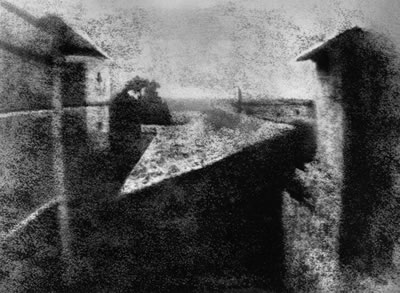 |
1826
JOSEPH NICEPHORE NIEPCE (1765 - 1833)
Using
a pewter plate that was sensitized with bitumen of Judea, Niépce
went into history as the producer of the first image that was ‚€œfixed‚€Ě
permanently. In our story of the history of the discovery of cinematography,
few names deserve the recognition Niepce does. Clearly, throughout
countless resources, histories, commentaries and documentation's,
Niepce must be recognized as the one who ahead of others, was able
to secure an image from further action of light. The Heliograph
as he called it, or ‚€œdrawing of the sun‚€Ě,
was made in a camera obscura and took an eight hour exposure.
The extant photograph is 8" x 6.5" and resides at the Harry Ransom
Humanities Research Center, The University of Texas at Austin. The
photograph is part of the Gernsheim Collection and is known as ‚€œView
From The Window At Le Gras‚€Ě.
This
image (left) is a reproduction print of gelatin silver
and watercolor made from the original photograph found in Niépce's
possessions. Immediately below, see the photograph in it's original
state. |
1826
- Earliest Extant Photograph? "View from the Window at Le Gras".
Joseph Nicephore
Niépce is credited with producing the world's first permanently
captured "image", which he called a Heliograph
(or Sun Drawing). Niépce's photograph (above)
was made in 1826 and was taken from a window looking out across
the roof tops of the Niépce home. He used a pewter plate that
was sensitized with bitumen of Judea. The photograph was made
in a camera obscura and took an eight -hour exposure. The extant
photograph is 8" x 6.5" and resides at the Harry Ransom Humanities
Research Center, The University of Texas at Austin. It was discovered
by chance, in March of 1952 in London when found along with letters
written by Niepce. The photograph is part of the Gernsheim Collection
and is known as ‚€œView From The Window At Le Gras‚€Ě.
In 1813, Niépce obtained an image but it was not fixed, and eventually
faded. (Image Source: the Gernsheim
Collection, Ransom Centre, University
of Texas, Austin), (Thanks to Robert Carter, Photographic Historical
Society of Canada).
This image (above)
is a reproduction print of gelatin silver and watercolor made
from the original photograph found in Niepce's possessions. Immediately
below, see the photograph in its original state. |
|
|
| |
|
|
| |
|
|
| |
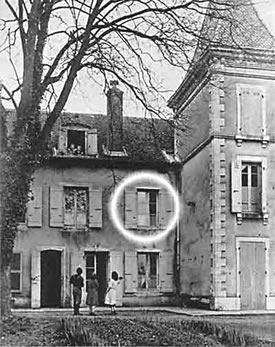 |
|
| In
his research of the Niépce photograph, Gernsheim visited
what remained of the property, writing "Part
of Niépce's house, showing the dormer window from which the
first photograph was taken." The
photo above is fig.19 from Helmut Gernsheim's 'History of Photography'.
|
Niépce's
Heliograph (above) prior to restoration through the Helmut
Gernsheim & Kodak Research Laboratory, March 21, 1952.
The pewter plate is identified as "G's Photograph".
The Gelatin silver print is 20.3 x 25.4 cm in size. |
| Photograph
(above) From Radio Times Hulton Picture Library |
|
| |
|
In
researching the place and angle from which the famous Niépce
photograph was taken from, historian Paul Marillier reconstructed
a model of the Niépce property at Le Gras. With many of
the buildings either gone now or changed, Marillier used maps
of the time and other graphical and photographical views including
a woodcut made from a photograph taken in 1850.
The model
was recreated to the correct scale from official documents of
the property published in 1833. This picture (right)
represents the findings of Marillier's work.
As Marillier
put it, "The purpose of this was
to make comparative tests of the possible points, from which "G's
photograph" was taken".
Material
taken from The Photographic Journal (London:
RPS), April 1967, Vol. 107 (4), pp130–40
|
|
| |
Photograph
(above) by Paul Marillier using his model to obtain the
correct window, angle and date that the 'View From
The Window At Le Gras' was taken. |
| |
|
| Marillier
and his associate Pierre Harmant dispute Gernsheim's claim that
Niépce used
a meniscus prism in the camera obscura when the photograph was taken.
Niépce ordered
one from Chevalier but found it unsatisfactory in acquiring a correct
image and returned it. Corresepondence from Chevalier's letters
identifies the date of the sending of the lens to February 1827.
Their (Gernsheim, Marillier, Harmant) combined and invaluable research
places the probable date the photograph was taken at between 4 June
and 18 July 1827. |
| |
|
| |
|
1825
- Earliest Extant Photograph? "Boy Leading His Horse"
JOSEPH NICEPHORE NIEPCE (1765 - 1833) |
| What
could likely be an even earlier "world's first photograph"
than ‚€œView From The Window At Le Gras‚€Ě , is yet another
Niépce Heliograph
known as "Boy Leading His Horse". The
photograph has been authenticated as having been produced in 1825,
almost one full year prior to Window At Le Gras, and is
accompanied by correspondence and letters written in Niépces'
own hand. The picture (below) is of a faded pen and ink
drawing of a boy and his horse. |
| |
|
The
Heliograph had been known of for 50 years. It
had been kept in the home of a Parisian collector of old books
and photos.
In 2002 it was auctioned off by Sotheby's and bought by the French
National Library (Bibliotheque Nationale) for a national
treasure at a price of $392,000US (£500,000). Sotheby's
listed it as "the earliest recorded
image created by photographic means."
Documents sold with the picture are not made public and no one
other than the owner can know for sure how the Heliograph
was made. The likely technique used by Niépce
would have been the coating of a copper plate with light-sensitive
bitumen, then taking a negative imprint of the pen and ink drawing
and use that in creating the Heliograph.
In exposing the light-sensitive coating to the sunlight, a positive
image is produced. |
|
| |
Joseph
Nicephore Niépces' 1825 Heliograph (above) 'Boy Leading
His Horse' |
| Developing
the plate with oil of lavender and white petroleum produced a negative
of the plate. The image was then etched into the metal producing
the plate. |
|
| The
'photograph' was not made in the camera obscura,
but was created using light-sensitive substances and the
use of direct sunlight. The evidence to date [February 2007] has
not been disputed. Niépce
cites the very 6-by-4 inch reproduction (the Heliograph)
in a letter to his son Isidore. The bookseller who owned the Niépce
photograph was identified as Andre Jammes who had been collecting
photographs since the 1950's. In a joint statement, Jammes and Sotheby's
proclaimed, "This image and its accompanying
correspondence oblige us to rewrite those crucial first stages of
the history of photography." |
|
|
| |
|
|
| |
|
|
| |
|
|
|
| |
|
|
|
| |
1827
JOSEPH NICEPHORE NIEPCE (1765 - 1833) |
|
|
| |
Niépce presented
a paper to the Royal Society in London including with it, several of his
Heliographs on metals and glass. Because his process
was kept from the work, he was refused the privilege of presenting. |
|
| |
|
|
|
| |
|
|
|
| |
1827
BASIL HALL (1788 - 1844) |
|
|
| |
Born in Edinburgh Scotland,
Hall wrote a book entitled ‚€˜Forty Etchings Made With The Camera
Lucida In North America‚€™ in which he sustained the instrument‚€™s
worth to the traveler, liberating him from ‚€œThe Triple Misery
Of Perspective, Proportion And Form‚€Ě. The publication of course,
includes forty etchings. |
|
| |
|
|
|
| |
|
|
|
| |
|
|
| |
|
|
| |
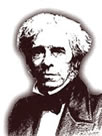 |
1827
MICHAEL FARADAY (1791 - 1867)
Faraday
wrote a piece in the ‚€˜Journal of the Royal Institute of
Great Britain‚€™, describing the motion phenomenon we see
as still movement or even reverse movement, actually comes from
varying degrees of speed in the forward motion. The immediate thought
upon reading this is the spinning wagon wheel of the western, which
although traveling in the forward motion of between 10-30 miles
per hour, appears to be either motionless, or moving backwards.
Faraday had been building a variety of mechanical wheels with spokes
turning at different speeds. |
|
|
| |
|
|
| |
|
|
| |
|
|
|
| |
|
|
|
| |
1827
(SIR) CHARLES WHEATSTONE (1802 - 1875) |
|
|
| |
Invents the Kaleidophone
which provided a combination of Kaleidoscope effects
with primitive musical sounds. |
|
| |
|
|
|
| |
|
|
|
| |
1828
JOSEPH ANTOINE FERDINAND PLATEAU (1801 - 1883) |
|
|
| |
Plateau had been investigating
persistence of vision at the University of Ghent, Belgium
and in 1829 published his experiments. In 1836 he will establish the law
of the ‚€˜stroboscopic effect‚€™. |
|
| |
|
|
|
| |
|
|
|
| |
1828
JAMES M. WATTLES ( - ) |
|
|
| |
A youth, Wattles attempts
to retain an image on plain paper that was soaked in potash and placed
within his camera obscura. His unsuccessful attempt was ridiculed by many
as simple "moonshine" thoughts. Henry
Snelling in 1849 wrote 'The History and Practice of the Art of
Photography' and in it made the false claime that Wattles was
the rightful inventor of photography. Snelling said Wattles invented photography
in 1828 but was reticent about announcing his discovery due to possible
"ridicule". Wattles referred to photographs as a
"Solar picture drawing".
|
|
| |
|
|
|
| |
|
|
|
| |
AUTHOR'S NOTE:
We believe it important to note
that up until the work of Marey and Muybridge (1872), pictures used for
the purpose of motion recreation, where all drawings or photographic-type
transparencies of posed motion. Even though Plateau suggested using photographs
in their place in 1848, it took another 24 years before happening. Muybridge
especially with his work in stop-action series photography, ultimately
paved the way for photographs to finally be used (over 50 years after
their discovery) in the formation of moving pictures. Then, subjects
did not have to be still or even pose as still. They could move freely
and be captured as moving, and then presented as if captured that way. |
|
| |
|
|
|
| |
|
|
|
| |
|
|
| |
|
|
| |
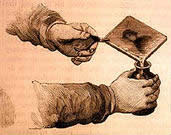 |
1829
J. N. NIEPCE and L. J. M. DAGUERRE
Sign
a ten year partnership agreement to mutually work on Heliography
and Daguerreotypes for the cause of photography.
Within some of the correspondence
Daguerre writes, "there should be
found some way of getting a large profit out of the invention before
publication...".
Daguerre
and Niepce began work in partnership on the process of photography.
|
|
|
| |
|
|
| |
|
|
| |
|
|
|
| |
|
|
|
| |
|
|
|
| |
|
|
|
| |
|
|
|
| |
|
|
|

|
| |



